Case Study Analysis: Cardiogenic Shock and Heart Failure in Lynora
VerifiedAdded on 2023/01/11
|10
|3377
|26
Case Study
AI Summary
This case study focuses on a 49-year-old female patient, Chitty Lynora, presenting with cardiogenic shock and heart failure. The assessment details her medical history of diabetes, hypertension, and rheumatic fever, along with her current non-compliance with prescribed medications. The analysis covers the pathophysiology of cardiogenic shock, its characteristic symptoms, and the consequential complications, including acute pulmonary edema. The study further explores the patient's symptoms of shortness of breath, fatigue, and weakness. Investigations like blood tests and echocardiograms are discussed, along with pharmacological interventions such as dopamine administration and treatments for acute pulmonary edema, including CPAP and BiPAP, and the rationale behind these treatments. The case study emphasizes the importance of diagnostic criteria, patient assessment, and the rationale for each intervention to manage the patient's condition effectively. The assignment includes a detailed analysis of the patient's condition, diagnostic tests, and treatment approaches.
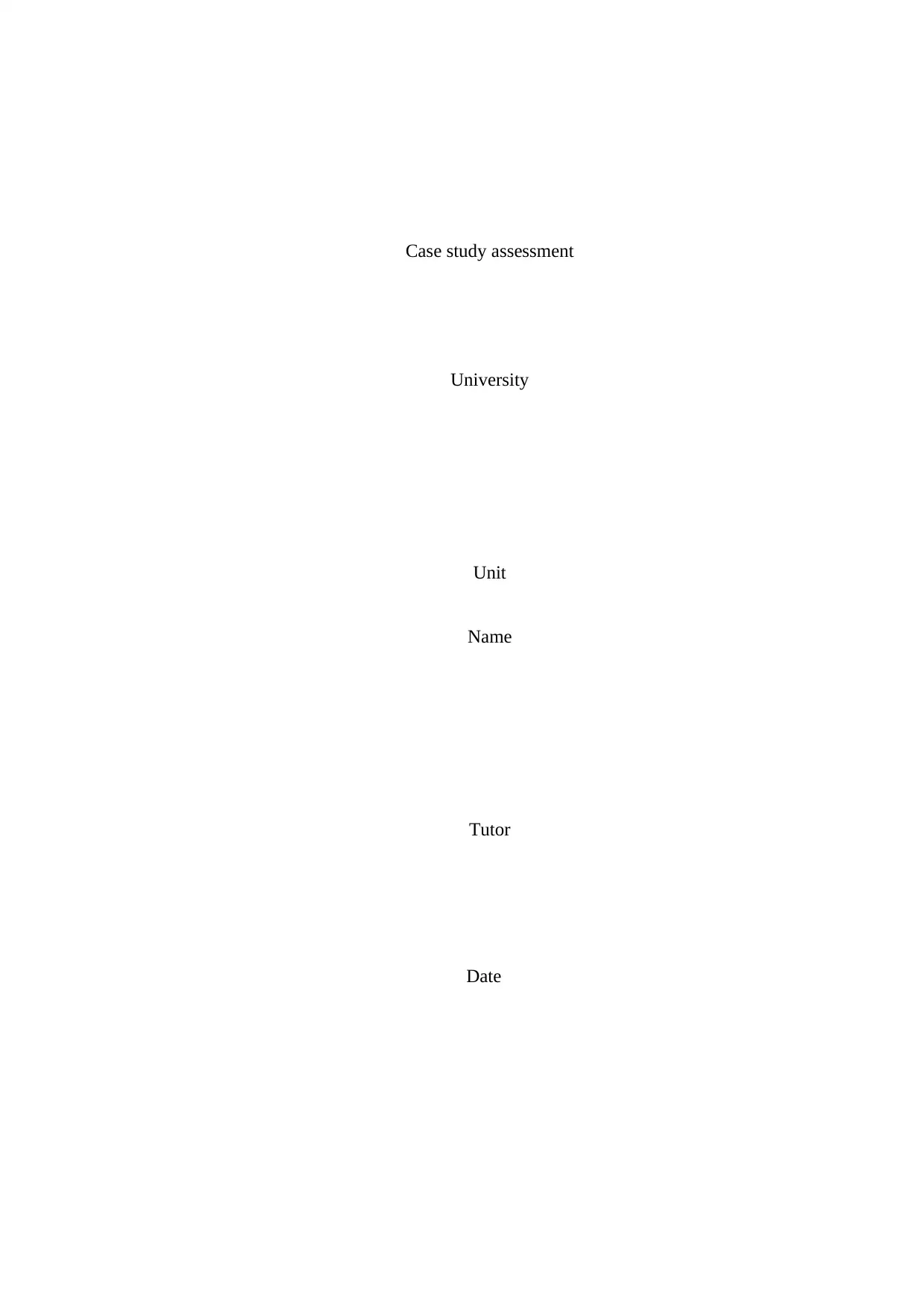
Case study assessment
University
Unit
Name
Tutor
Date
University
Unit
Name
Tutor
Date
Paraphrase This Document
Need a fresh take? Get an instant paraphrase of this document with our AI Paraphraser
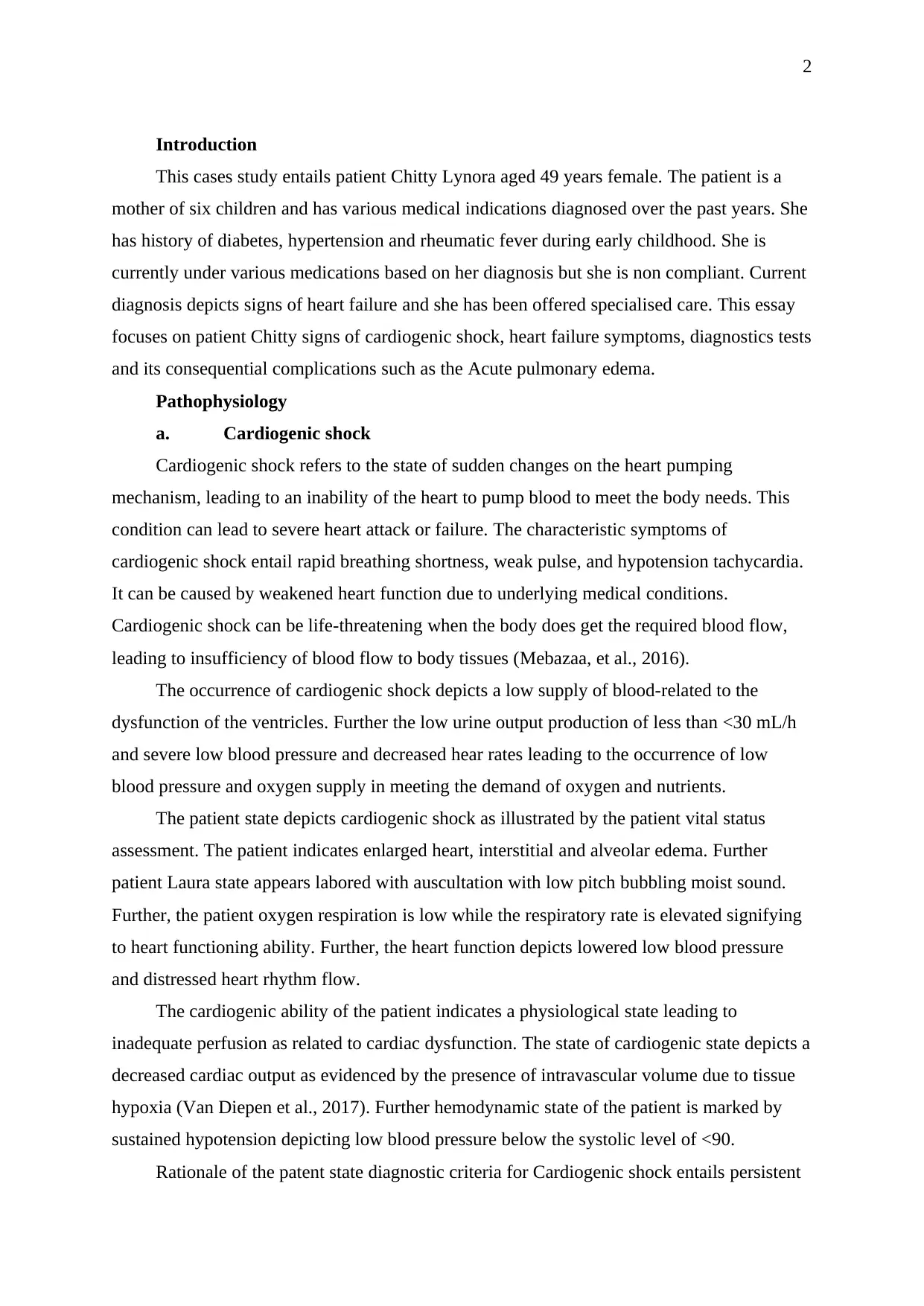
2
Introduction
This cases study entails patient Chitty Lynora aged 49 years female. The patient is a
mother of six children and has various medical indications diagnosed over the past years. She
has history of diabetes, hypertension and rheumatic fever during early childhood. She is
currently under various medications based on her diagnosis but she is non compliant. Current
diagnosis depicts signs of heart failure and she has been offered specialised care. This essay
focuses on patient Chitty signs of cardiogenic shock, heart failure symptoms, diagnostics tests
and its consequential complications such as the Acute pulmonary edema.
Pathophysiology
a. Cardiogenic shock
Cardiogenic shock refers to the state of sudden changes on the heart pumping
mechanism, leading to an inability of the heart to pump blood to meet the body needs. This
condition can lead to severe heart attack or failure. The characteristic symptoms of
cardiogenic shock entail rapid breathing shortness, weak pulse, and hypotension tachycardia.
It can be caused by weakened heart function due to underlying medical conditions.
Cardiogenic shock can be life-threatening when the body does get the required blood flow,
leading to insufficiency of blood flow to body tissues (Mebazaa, et al., 2016).
The occurrence of cardiogenic shock depicts a low supply of blood-related to the
dysfunction of the ventricles. Further the low urine output production of less than <30 mL/h
and severe low blood pressure and decreased hear rates leading to the occurrence of low
blood pressure and oxygen supply in meeting the demand of oxygen and nutrients.
The patient state depicts cardiogenic shock as illustrated by the patient vital status
assessment. The patient indicates enlarged heart, interstitial and alveolar edema. Further
patient Laura state appears labored with auscultation with low pitch bubbling moist sound.
Further, the patient oxygen respiration is low while the respiratory rate is elevated signifying
to heart functioning ability. Further, the heart function depicts lowered low blood pressure
and distressed heart rhythm flow.
The cardiogenic ability of the patient indicates a physiological state leading to
inadequate perfusion as related to cardiac dysfunction. The state of cardiogenic state depicts a
decreased cardiac output as evidenced by the presence of intravascular volume due to tissue
hypoxia (Van Diepen et al., 2017). Further hemodynamic state of the patient is marked by
sustained hypotension depicting low blood pressure below the systolic level of <90.
Rationale of the patent state diagnostic criteria for Cardiogenic shock entails persistent
Introduction
This cases study entails patient Chitty Lynora aged 49 years female. The patient is a
mother of six children and has various medical indications diagnosed over the past years. She
has history of diabetes, hypertension and rheumatic fever during early childhood. She is
currently under various medications based on her diagnosis but she is non compliant. Current
diagnosis depicts signs of heart failure and she has been offered specialised care. This essay
focuses on patient Chitty signs of cardiogenic shock, heart failure symptoms, diagnostics tests
and its consequential complications such as the Acute pulmonary edema.
Pathophysiology
a. Cardiogenic shock
Cardiogenic shock refers to the state of sudden changes on the heart pumping
mechanism, leading to an inability of the heart to pump blood to meet the body needs. This
condition can lead to severe heart attack or failure. The characteristic symptoms of
cardiogenic shock entail rapid breathing shortness, weak pulse, and hypotension tachycardia.
It can be caused by weakened heart function due to underlying medical conditions.
Cardiogenic shock can be life-threatening when the body does get the required blood flow,
leading to insufficiency of blood flow to body tissues (Mebazaa, et al., 2016).
The occurrence of cardiogenic shock depicts a low supply of blood-related to the
dysfunction of the ventricles. Further the low urine output production of less than <30 mL/h
and severe low blood pressure and decreased hear rates leading to the occurrence of low
blood pressure and oxygen supply in meeting the demand of oxygen and nutrients.
The patient state depicts cardiogenic shock as illustrated by the patient vital status
assessment. The patient indicates enlarged heart, interstitial and alveolar edema. Further
patient Laura state appears labored with auscultation with low pitch bubbling moist sound.
Further, the patient oxygen respiration is low while the respiratory rate is elevated signifying
to heart functioning ability. Further, the heart function depicts lowered low blood pressure
and distressed heart rhythm flow.
The cardiogenic ability of the patient indicates a physiological state leading to
inadequate perfusion as related to cardiac dysfunction. The state of cardiogenic state depicts a
decreased cardiac output as evidenced by the presence of intravascular volume due to tissue
hypoxia (Van Diepen et al., 2017). Further hemodynamic state of the patient is marked by
sustained hypotension depicting low blood pressure below the systolic level of <90.
Rationale of the patent state diagnostic criteria for Cardiogenic shock entails persistent
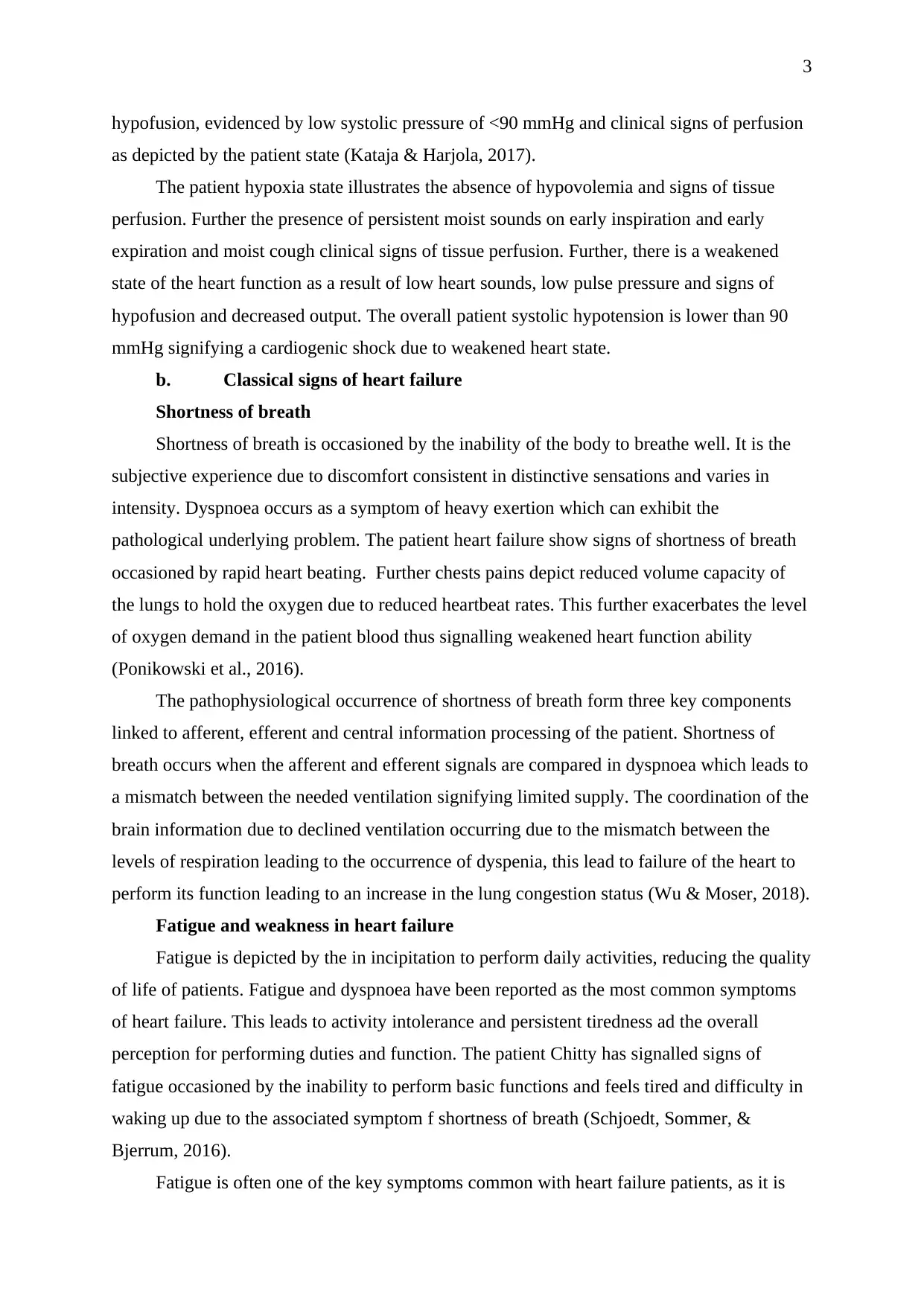
3
hypofusion, evidenced by low systolic pressure of <90 mmHg and clinical signs of perfusion
as depicted by the patient state (Kataja & Harjola, 2017).
The patient hypoxia state illustrates the absence of hypovolemia and signs of tissue
perfusion. Further the presence of persistent moist sounds on early inspiration and early
expiration and moist cough clinical signs of tissue perfusion. Further, there is a weakened
state of the heart function as a result of low heart sounds, low pulse pressure and signs of
hypofusion and decreased output. The overall patient systolic hypotension is lower than 90
mmHg signifying a cardiogenic shock due to weakened heart state.
b. Classical signs of heart failure
Shortness of breath
Shortness of breath is occasioned by the inability of the body to breathe well. It is the
subjective experience due to discomfort consistent in distinctive sensations and varies in
intensity. Dyspnoea occurs as a symptom of heavy exertion which can exhibit the
pathological underlying problem. The patient heart failure show signs of shortness of breath
occasioned by rapid heart beating. Further chests pains depict reduced volume capacity of
the lungs to hold the oxygen due to reduced heartbeat rates. This further exacerbates the level
of oxygen demand in the patient blood thus signalling weakened heart function ability
(Ponikowski et al., 2016).
The pathophysiological occurrence of shortness of breath form three key components
linked to afferent, efferent and central information processing of the patient. Shortness of
breath occurs when the afferent and efferent signals are compared in dyspnoea which leads to
a mismatch between the needed ventilation signifying limited supply. The coordination of the
brain information due to declined ventilation occurring due to the mismatch between the
levels of respiration leading to the occurrence of dyspenia, this lead to failure of the heart to
perform its function leading to an increase in the lung congestion status (Wu & Moser, 2018).
Fatigue and weakness in heart failure
Fatigue is depicted by the in incipitation to perform daily activities, reducing the quality
of life of patients. Fatigue and dyspnoea have been reported as the most common symptoms
of heart failure. This leads to activity intolerance and persistent tiredness ad the overall
perception for performing duties and function. The patient Chitty has signalled signs of
fatigue occasioned by the inability to perform basic functions and feels tired and difficulty in
waking up due to the associated symptom f shortness of breath (Schjoedt, Sommer, &
Bjerrum, 2016).
Fatigue is often one of the key symptoms common with heart failure patients, as it is
hypofusion, evidenced by low systolic pressure of <90 mmHg and clinical signs of perfusion
as depicted by the patient state (Kataja & Harjola, 2017).
The patient hypoxia state illustrates the absence of hypovolemia and signs of tissue
perfusion. Further the presence of persistent moist sounds on early inspiration and early
expiration and moist cough clinical signs of tissue perfusion. Further, there is a weakened
state of the heart function as a result of low heart sounds, low pulse pressure and signs of
hypofusion and decreased output. The overall patient systolic hypotension is lower than 90
mmHg signifying a cardiogenic shock due to weakened heart state.
b. Classical signs of heart failure
Shortness of breath
Shortness of breath is occasioned by the inability of the body to breathe well. It is the
subjective experience due to discomfort consistent in distinctive sensations and varies in
intensity. Dyspnoea occurs as a symptom of heavy exertion which can exhibit the
pathological underlying problem. The patient heart failure show signs of shortness of breath
occasioned by rapid heart beating. Further chests pains depict reduced volume capacity of
the lungs to hold the oxygen due to reduced heartbeat rates. This further exacerbates the level
of oxygen demand in the patient blood thus signalling weakened heart function ability
(Ponikowski et al., 2016).
The pathophysiological occurrence of shortness of breath form three key components
linked to afferent, efferent and central information processing of the patient. Shortness of
breath occurs when the afferent and efferent signals are compared in dyspnoea which leads to
a mismatch between the needed ventilation signifying limited supply. The coordination of the
brain information due to declined ventilation occurring due to the mismatch between the
levels of respiration leading to the occurrence of dyspenia, this lead to failure of the heart to
perform its function leading to an increase in the lung congestion status (Wu & Moser, 2018).
Fatigue and weakness in heart failure
Fatigue is depicted by the in incipitation to perform daily activities, reducing the quality
of life of patients. Fatigue and dyspnoea have been reported as the most common symptoms
of heart failure. This leads to activity intolerance and persistent tiredness ad the overall
perception for performing duties and function. The patient Chitty has signalled signs of
fatigue occasioned by the inability to perform basic functions and feels tired and difficulty in
waking up due to the associated symptom f shortness of breath (Schjoedt, Sommer, &
Bjerrum, 2016).
Fatigue is often one of the key symptoms common with heart failure patients, as it is
⊘ This is a preview!⊘
Do you want full access?
Subscribe today to unlock all pages.

Trusted by 1+ million students worldwide
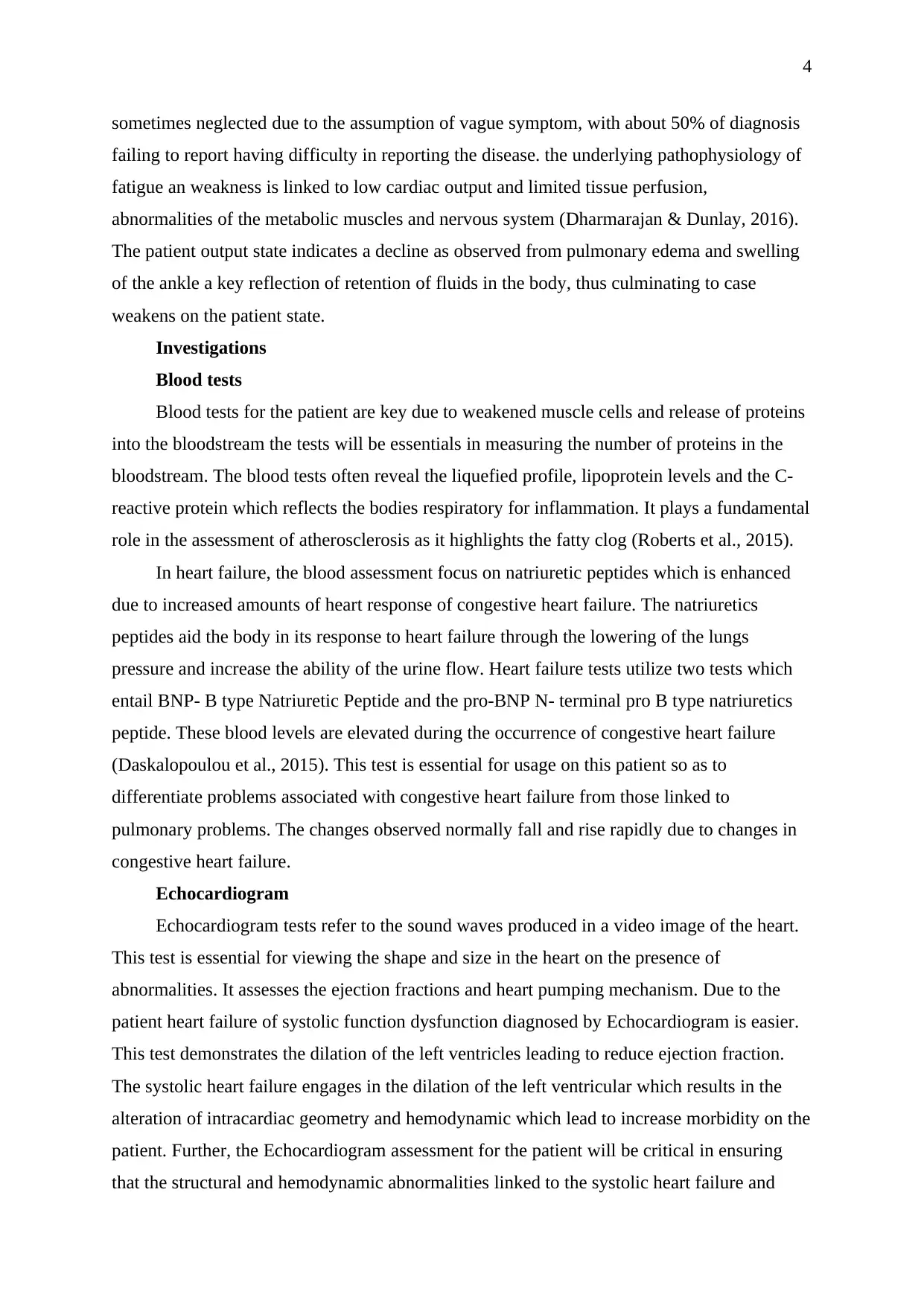
4
sometimes neglected due to the assumption of vague symptom, with about 50% of diagnosis
failing to report having difficulty in reporting the disease. the underlying pathophysiology of
fatigue an weakness is linked to low cardiac output and limited tissue perfusion,
abnormalities of the metabolic muscles and nervous system (Dharmarajan & Dunlay, 2016).
The patient output state indicates a decline as observed from pulmonary edema and swelling
of the ankle a key reflection of retention of fluids in the body, thus culminating to case
weakens on the patient state.
Investigations
Blood tests
Blood tests for the patient are key due to weakened muscle cells and release of proteins
into the bloodstream the tests will be essentials in measuring the number of proteins in the
bloodstream. The blood tests often reveal the liquefied profile, lipoprotein levels and the C-
reactive protein which reflects the bodies respiratory for inflammation. It plays a fundamental
role in the assessment of atherosclerosis as it highlights the fatty clog (Roberts et al., 2015).
In heart failure, the blood assessment focus on natriuretic peptides which is enhanced
due to increased amounts of heart response of congestive heart failure. The natriuretics
peptides aid the body in its response to heart failure through the lowering of the lungs
pressure and increase the ability of the urine flow. Heart failure tests utilize two tests which
entail BNP- B type Natriuretic Peptide and the pro-BNP N- terminal pro B type natriuretics
peptide. These blood levels are elevated during the occurrence of congestive heart failure
(Daskalopoulou et al., 2015). This test is essential for usage on this patient so as to
differentiate problems associated with congestive heart failure from those linked to
pulmonary problems. The changes observed normally fall and rise rapidly due to changes in
congestive heart failure.
Echocardiogram
Echocardiogram tests refer to the sound waves produced in a video image of the heart.
This test is essential for viewing the shape and size in the heart on the presence of
abnormalities. It assesses the ejection fractions and heart pumping mechanism. Due to the
patient heart failure of systolic function dysfunction diagnosed by Echocardiogram is easier.
This test demonstrates the dilation of the left ventricles leading to reduce ejection fraction.
The systolic heart failure engages in the dilation of the left ventricular which results in the
alteration of intracardiac geometry and hemodynamic which lead to increase morbidity on the
patient. Further, the Echocardiogram assessment for the patient will be critical in ensuring
that the structural and hemodynamic abnormalities linked to the systolic heart failure and
sometimes neglected due to the assumption of vague symptom, with about 50% of diagnosis
failing to report having difficulty in reporting the disease. the underlying pathophysiology of
fatigue an weakness is linked to low cardiac output and limited tissue perfusion,
abnormalities of the metabolic muscles and nervous system (Dharmarajan & Dunlay, 2016).
The patient output state indicates a decline as observed from pulmonary edema and swelling
of the ankle a key reflection of retention of fluids in the body, thus culminating to case
weakens on the patient state.
Investigations
Blood tests
Blood tests for the patient are key due to weakened muscle cells and release of proteins
into the bloodstream the tests will be essentials in measuring the number of proteins in the
bloodstream. The blood tests often reveal the liquefied profile, lipoprotein levels and the C-
reactive protein which reflects the bodies respiratory for inflammation. It plays a fundamental
role in the assessment of atherosclerosis as it highlights the fatty clog (Roberts et al., 2015).
In heart failure, the blood assessment focus on natriuretic peptides which is enhanced
due to increased amounts of heart response of congestive heart failure. The natriuretics
peptides aid the body in its response to heart failure through the lowering of the lungs
pressure and increase the ability of the urine flow. Heart failure tests utilize two tests which
entail BNP- B type Natriuretic Peptide and the pro-BNP N- terminal pro B type natriuretics
peptide. These blood levels are elevated during the occurrence of congestive heart failure
(Daskalopoulou et al., 2015). This test is essential for usage on this patient so as to
differentiate problems associated with congestive heart failure from those linked to
pulmonary problems. The changes observed normally fall and rise rapidly due to changes in
congestive heart failure.
Echocardiogram
Echocardiogram tests refer to the sound waves produced in a video image of the heart.
This test is essential for viewing the shape and size in the heart on the presence of
abnormalities. It assesses the ejection fractions and heart pumping mechanism. Due to the
patient heart failure of systolic function dysfunction diagnosed by Echocardiogram is easier.
This test demonstrates the dilation of the left ventricles leading to reduce ejection fraction.
The systolic heart failure engages in the dilation of the left ventricular which results in the
alteration of intracardiac geometry and hemodynamic which lead to increase morbidity on the
patient. Further, the Echocardiogram assessment for the patient will be critical in ensuring
that the structural and hemodynamic abnormalities linked to the systolic heart failure and
Paraphrase This Document
Need a fresh take? Get an instant paraphrase of this document with our AI Paraphraser
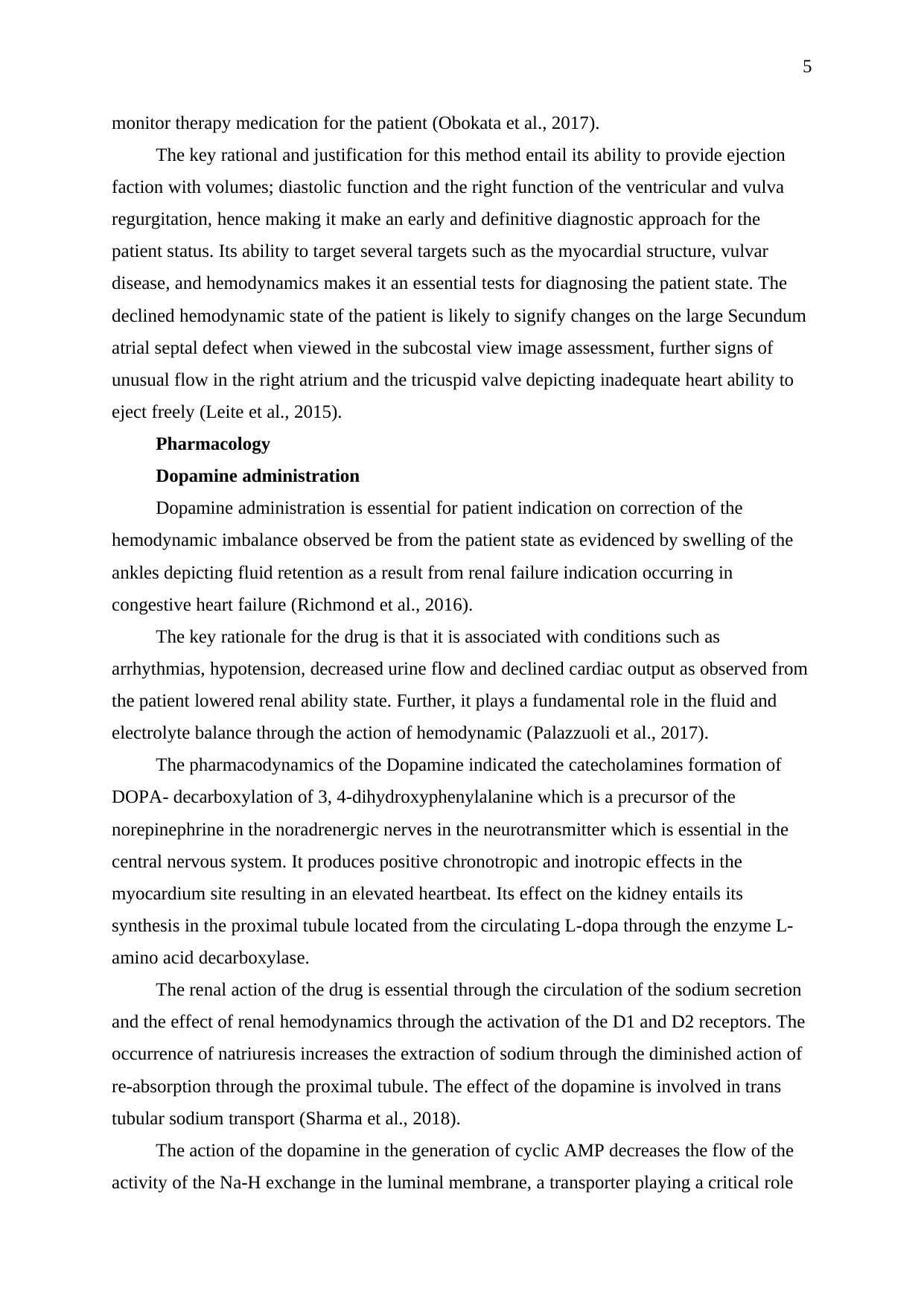
5
monitor therapy medication for the patient (Obokata et al., 2017).
The key rational and justification for this method entail its ability to provide ejection
faction with volumes; diastolic function and the right function of the ventricular and vulva
regurgitation, hence making it make an early and definitive diagnostic approach for the
patient status. Its ability to target several targets such as the myocardial structure, vulvar
disease, and hemodynamics makes it an essential tests for diagnosing the patient state. The
declined hemodynamic state of the patient is likely to signify changes on the large Secundum
atrial septal defect when viewed in the subcostal view image assessment, further signs of
unusual flow in the right atrium and the tricuspid valve depicting inadequate heart ability to
eject freely (Leite et al., 2015).
Pharmacology
Dopamine administration
Dopamine administration is essential for patient indication on correction of the
hemodynamic imbalance observed be from the patient state as evidenced by swelling of the
ankles depicting fluid retention as a result from renal failure indication occurring in
congestive heart failure (Richmond et al., 2016).
The key rationale for the drug is that it is associated with conditions such as
arrhythmias, hypotension, decreased urine flow and declined cardiac output as observed from
the patient lowered renal ability state. Further, it plays a fundamental role in the fluid and
electrolyte balance through the action of hemodynamic (Palazzuoli et al., 2017).
The pharmacodynamics of the Dopamine indicated the catecholamines formation of
DOPA- decarboxylation of 3, 4-dihydroxyphenylalanine which is a precursor of the
norepinephrine in the noradrenergic nerves in the neurotransmitter which is essential in the
central nervous system. It produces positive chronotropic and inotropic effects in the
myocardium site resulting in an elevated heartbeat. Its effect on the kidney entails its
synthesis in the proximal tubule located from the circulating L-dopa through the enzyme L-
amino acid decarboxylase.
The renal action of the drug is essential through the circulation of the sodium secretion
and the effect of renal hemodynamics through the activation of the D1 and D2 receptors. The
occurrence of natriuresis increases the extraction of sodium through the diminished action of
re-absorption through the proximal tubule. The effect of the dopamine is involved in trans
tubular sodium transport (Sharma et al., 2018).
The action of the dopamine in the generation of cyclic AMP decreases the flow of the
activity of the Na-H exchange in the luminal membrane, a transporter playing a critical role
monitor therapy medication for the patient (Obokata et al., 2017).
The key rational and justification for this method entail its ability to provide ejection
faction with volumes; diastolic function and the right function of the ventricular and vulva
regurgitation, hence making it make an early and definitive diagnostic approach for the
patient status. Its ability to target several targets such as the myocardial structure, vulvar
disease, and hemodynamics makes it an essential tests for diagnosing the patient state. The
declined hemodynamic state of the patient is likely to signify changes on the large Secundum
atrial septal defect when viewed in the subcostal view image assessment, further signs of
unusual flow in the right atrium and the tricuspid valve depicting inadequate heart ability to
eject freely (Leite et al., 2015).
Pharmacology
Dopamine administration
Dopamine administration is essential for patient indication on correction of the
hemodynamic imbalance observed be from the patient state as evidenced by swelling of the
ankles depicting fluid retention as a result from renal failure indication occurring in
congestive heart failure (Richmond et al., 2016).
The key rationale for the drug is that it is associated with conditions such as
arrhythmias, hypotension, decreased urine flow and declined cardiac output as observed from
the patient lowered renal ability state. Further, it plays a fundamental role in the fluid and
electrolyte balance through the action of hemodynamic (Palazzuoli et al., 2017).
The pharmacodynamics of the Dopamine indicated the catecholamines formation of
DOPA- decarboxylation of 3, 4-dihydroxyphenylalanine which is a precursor of the
norepinephrine in the noradrenergic nerves in the neurotransmitter which is essential in the
central nervous system. It produces positive chronotropic and inotropic effects in the
myocardium site resulting in an elevated heartbeat. Its effect on the kidney entails its
synthesis in the proximal tubule located from the circulating L-dopa through the enzyme L-
amino acid decarboxylase.
The renal action of the drug is essential through the circulation of the sodium secretion
and the effect of renal hemodynamics through the activation of the D1 and D2 receptors. The
occurrence of natriuresis increases the extraction of sodium through the diminished action of
re-absorption through the proximal tubule. The effect of the dopamine is involved in trans
tubular sodium transport (Sharma et al., 2018).
The action of the dopamine in the generation of cyclic AMP decreases the flow of the
activity of the Na-H exchange in the luminal membrane, a transporter playing a critical role
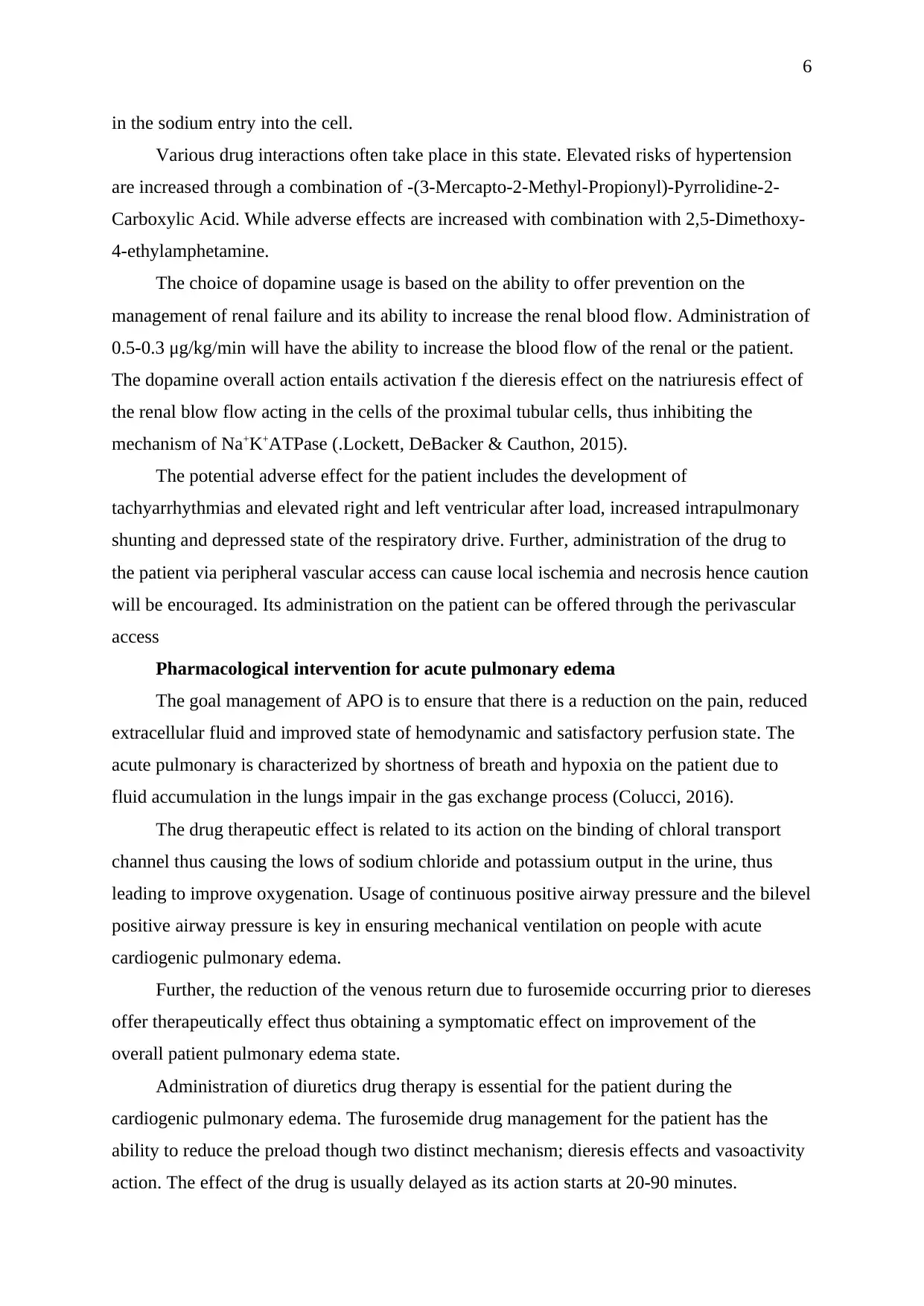
6
in the sodium entry into the cell.
Various drug interactions often take place in this state. Elevated risks of hypertension
are increased through a combination of -(3-Mercapto-2-Methyl-Propionyl)-Pyrrolidine-2-
Carboxylic Acid. While adverse effects are increased with combination with 2,5-Dimethoxy-
4-ethylamphetamine.
The choice of dopamine usage is based on the ability to offer prevention on the
management of renal failure and its ability to increase the renal blood flow. Administration of
0.5-0.3 μg/kg/min will have the ability to increase the blood flow of the renal or the patient.
The dopamine overall action entails activation f the dieresis effect on the natriuresis effect of
the renal blow flow acting in the cells of the proximal tubular cells, thus inhibiting the
mechanism of Na+K+ATPase (.Lockett, DeBacker & Cauthon, 2015).
The potential adverse effect for the patient includes the development of
tachyarrhythmias and elevated right and left ventricular after load, increased intrapulmonary
shunting and depressed state of the respiratory drive. Further, administration of the drug to
the patient via peripheral vascular access can cause local ischemia and necrosis hence caution
will be encouraged. Its administration on the patient can be offered through the perivascular
access
Pharmacological intervention for acute pulmonary edema
The goal management of APO is to ensure that there is a reduction on the pain, reduced
extracellular fluid and improved state of hemodynamic and satisfactory perfusion state. The
acute pulmonary is characterized by shortness of breath and hypoxia on the patient due to
fluid accumulation in the lungs impair in the gas exchange process (Colucci, 2016).
The drug therapeutic effect is related to its action on the binding of chloral transport
channel thus causing the lows of sodium chloride and potassium output in the urine, thus
leading to improve oxygenation. Usage of continuous positive airway pressure and the bilevel
positive airway pressure is key in ensuring mechanical ventilation on people with acute
cardiogenic pulmonary edema.
Further, the reduction of the venous return due to furosemide occurring prior to diereses
offer therapeutically effect thus obtaining a symptomatic effect on improvement of the
overall patient pulmonary edema state.
Administration of diuretics drug therapy is essential for the patient during the
cardiogenic pulmonary edema. The furosemide drug management for the patient has the
ability to reduce the preload though two distinct mechanism; dieresis effects and vasoactivity
action. The effect of the drug is usually delayed as its action starts at 20-90 minutes.
in the sodium entry into the cell.
Various drug interactions often take place in this state. Elevated risks of hypertension
are increased through a combination of -(3-Mercapto-2-Methyl-Propionyl)-Pyrrolidine-2-
Carboxylic Acid. While adverse effects are increased with combination with 2,5-Dimethoxy-
4-ethylamphetamine.
The choice of dopamine usage is based on the ability to offer prevention on the
management of renal failure and its ability to increase the renal blood flow. Administration of
0.5-0.3 μg/kg/min will have the ability to increase the blood flow of the renal or the patient.
The dopamine overall action entails activation f the dieresis effect on the natriuresis effect of
the renal blow flow acting in the cells of the proximal tubular cells, thus inhibiting the
mechanism of Na+K+ATPase (.Lockett, DeBacker & Cauthon, 2015).
The potential adverse effect for the patient includes the development of
tachyarrhythmias and elevated right and left ventricular after load, increased intrapulmonary
shunting and depressed state of the respiratory drive. Further, administration of the drug to
the patient via peripheral vascular access can cause local ischemia and necrosis hence caution
will be encouraged. Its administration on the patient can be offered through the perivascular
access
Pharmacological intervention for acute pulmonary edema
The goal management of APO is to ensure that there is a reduction on the pain, reduced
extracellular fluid and improved state of hemodynamic and satisfactory perfusion state. The
acute pulmonary is characterized by shortness of breath and hypoxia on the patient due to
fluid accumulation in the lungs impair in the gas exchange process (Colucci, 2016).
The drug therapeutic effect is related to its action on the binding of chloral transport
channel thus causing the lows of sodium chloride and potassium output in the urine, thus
leading to improve oxygenation. Usage of continuous positive airway pressure and the bilevel
positive airway pressure is key in ensuring mechanical ventilation on people with acute
cardiogenic pulmonary edema.
Further, the reduction of the venous return due to furosemide occurring prior to diereses
offer therapeutically effect thus obtaining a symptomatic effect on improvement of the
overall patient pulmonary edema state.
Administration of diuretics drug therapy is essential for the patient during the
cardiogenic pulmonary edema. The furosemide drug management for the patient has the
ability to reduce the preload though two distinct mechanism; dieresis effects and vasoactivity
action. The effect of the drug is usually delayed as its action starts at 20-90 minutes.
⊘ This is a preview!⊘
Do you want full access?
Subscribe today to unlock all pages.

Trusted by 1+ million students worldwide
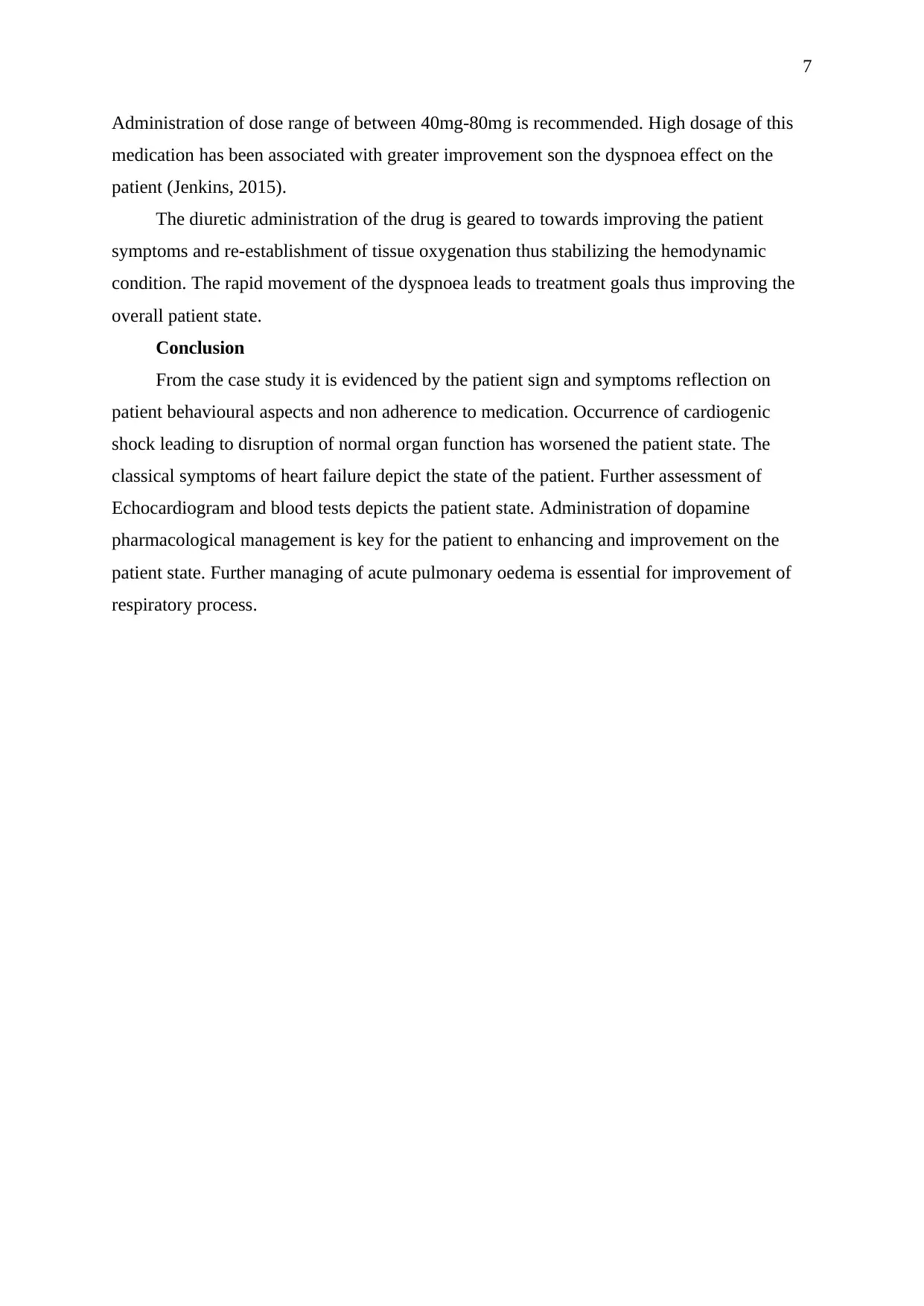
7
Administration of dose range of between 40mg-80mg is recommended. High dosage of this
medication has been associated with greater improvement son the dyspnoea effect on the
patient (Jenkins, 2015).
The diuretic administration of the drug is geared to towards improving the patient
symptoms and re-establishment of tissue oxygenation thus stabilizing the hemodynamic
condition. The rapid movement of the dyspnoea leads to treatment goals thus improving the
overall patient state.
Conclusion
From the case study it is evidenced by the patient sign and symptoms reflection on
patient behavioural aspects and non adherence to medication. Occurrence of cardiogenic
shock leading to disruption of normal organ function has worsened the patient state. The
classical symptoms of heart failure depict the state of the patient. Further assessment of
Echocardiogram and blood tests depicts the patient state. Administration of dopamine
pharmacological management is key for the patient to enhancing and improvement on the
patient state. Further managing of acute pulmonary oedema is essential for improvement of
respiratory process.
Administration of dose range of between 40mg-80mg is recommended. High dosage of this
medication has been associated with greater improvement son the dyspnoea effect on the
patient (Jenkins, 2015).
The diuretic administration of the drug is geared to towards improving the patient
symptoms and re-establishment of tissue oxygenation thus stabilizing the hemodynamic
condition. The rapid movement of the dyspnoea leads to treatment goals thus improving the
overall patient state.
Conclusion
From the case study it is evidenced by the patient sign and symptoms reflection on
patient behavioural aspects and non adherence to medication. Occurrence of cardiogenic
shock leading to disruption of normal organ function has worsened the patient state. The
classical symptoms of heart failure depict the state of the patient. Further assessment of
Echocardiogram and blood tests depicts the patient state. Administration of dopamine
pharmacological management is key for the patient to enhancing and improvement on the
patient state. Further managing of acute pulmonary oedema is essential for improvement of
respiratory process.
Paraphrase This Document
Need a fresh take? Get an instant paraphrase of this document with our AI Paraphraser
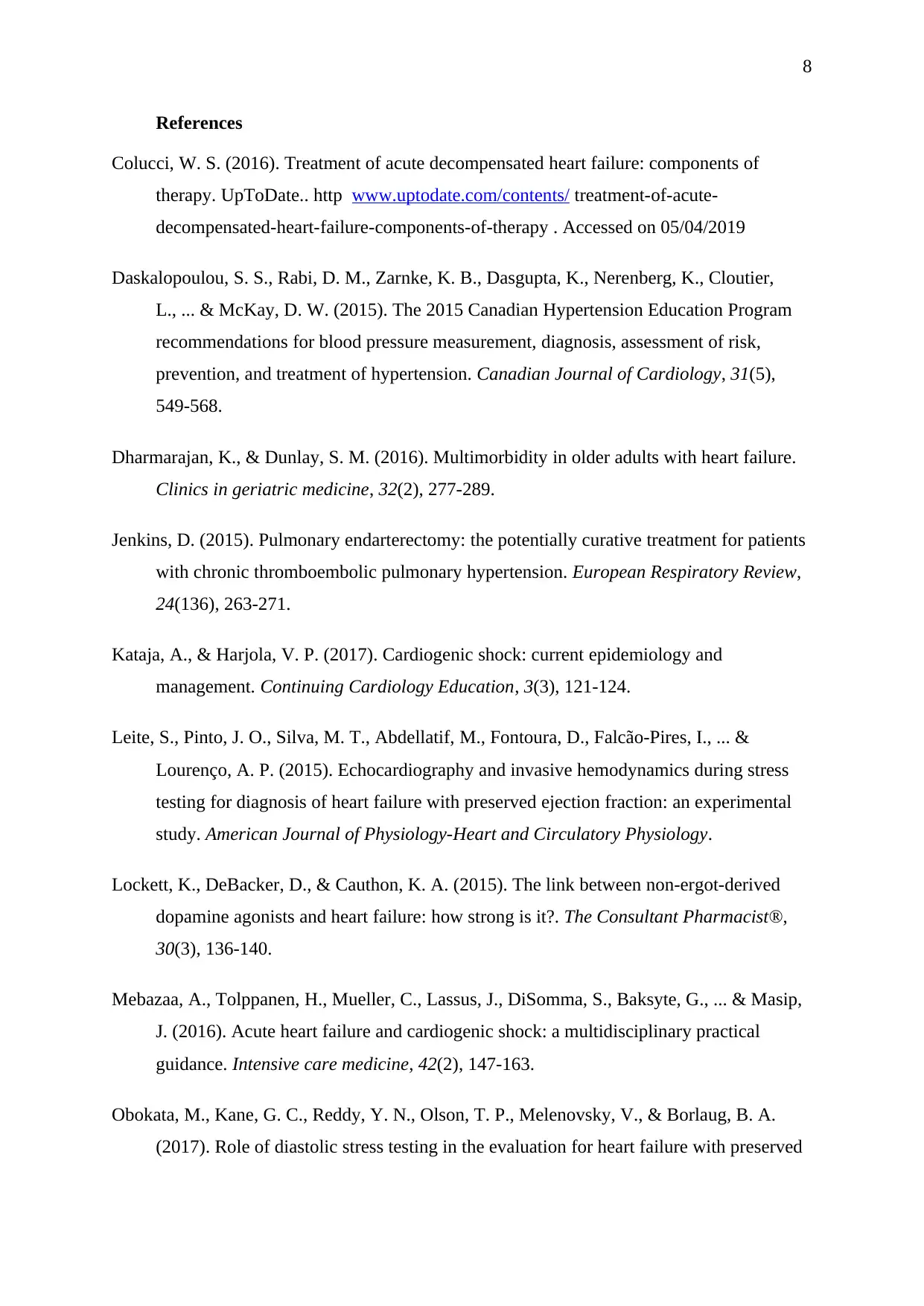
8
References
Colucci, W. S. (2016). Treatment of acute decompensated heart failure: components of
therapy. UpToDate.. http www.uptodate.com/contents/ treatment-of-acute-
decompensated-heart-failure-components-of-therapy . Accessed on 05/04/2019
Daskalopoulou, S. S., Rabi, D. M., Zarnke, K. B., Dasgupta, K., Nerenberg, K., Cloutier,
L., ... & McKay, D. W. (2015). The 2015 Canadian Hypertension Education Program
recommendations for blood pressure measurement, diagnosis, assessment of risk,
prevention, and treatment of hypertension. Canadian Journal of Cardiology, 31(5),
549-568.
Dharmarajan, K., & Dunlay, S. M. (2016). Multimorbidity in older adults with heart failure.
Clinics in geriatric medicine, 32(2), 277-289.
Jenkins, D. (2015). Pulmonary endarterectomy: the potentially curative treatment for patients
with chronic thromboembolic pulmonary hypertension. European Respiratory Review,
24(136), 263-271.
Kataja, A., & Harjola, V. P. (2017). Cardiogenic shock: current epidemiology and
management. Continuing Cardiology Education, 3(3), 121-124.
Leite, S., Pinto, J. O., Silva, M. T., Abdellatif, M., Fontoura, D., Falcão-Pires, I., ... &
Lourenço, A. P. (2015). Echocardiography and invasive hemodynamics during stress
testing for diagnosis of heart failure with preserved ejection fraction: an experimental
study. American Journal of Physiology-Heart and Circulatory Physiology.
Lockett, K., DeBacker, D., & Cauthon, K. A. (2015). The link between non-ergot-derived
dopamine agonists and heart failure: how strong is it?. The Consultant Pharmacist®,
30(3), 136-140.
Mebazaa, A., Tolppanen, H., Mueller, C., Lassus, J., DiSomma, S., Baksyte, G., ... & Masip,
J. (2016). Acute heart failure and cardiogenic shock: a multidisciplinary practical
guidance. Intensive care medicine, 42(2), 147-163.
Obokata, M., Kane, G. C., Reddy, Y. N., Olson, T. P., Melenovsky, V., & Borlaug, B. A.
(2017). Role of diastolic stress testing in the evaluation for heart failure with preserved
References
Colucci, W. S. (2016). Treatment of acute decompensated heart failure: components of
therapy. UpToDate.. http www.uptodate.com/contents/ treatment-of-acute-
decompensated-heart-failure-components-of-therapy . Accessed on 05/04/2019
Daskalopoulou, S. S., Rabi, D. M., Zarnke, K. B., Dasgupta, K., Nerenberg, K., Cloutier,
L., ... & McKay, D. W. (2015). The 2015 Canadian Hypertension Education Program
recommendations for blood pressure measurement, diagnosis, assessment of risk,
prevention, and treatment of hypertension. Canadian Journal of Cardiology, 31(5),
549-568.
Dharmarajan, K., & Dunlay, S. M. (2016). Multimorbidity in older adults with heart failure.
Clinics in geriatric medicine, 32(2), 277-289.
Jenkins, D. (2015). Pulmonary endarterectomy: the potentially curative treatment for patients
with chronic thromboembolic pulmonary hypertension. European Respiratory Review,
24(136), 263-271.
Kataja, A., & Harjola, V. P. (2017). Cardiogenic shock: current epidemiology and
management. Continuing Cardiology Education, 3(3), 121-124.
Leite, S., Pinto, J. O., Silva, M. T., Abdellatif, M., Fontoura, D., Falcão-Pires, I., ... &
Lourenço, A. P. (2015). Echocardiography and invasive hemodynamics during stress
testing for diagnosis of heart failure with preserved ejection fraction: an experimental
study. American Journal of Physiology-Heart and Circulatory Physiology.
Lockett, K., DeBacker, D., & Cauthon, K. A. (2015). The link between non-ergot-derived
dopamine agonists and heart failure: how strong is it?. The Consultant Pharmacist®,
30(3), 136-140.
Mebazaa, A., Tolppanen, H., Mueller, C., Lassus, J., DiSomma, S., Baksyte, G., ... & Masip,
J. (2016). Acute heart failure and cardiogenic shock: a multidisciplinary practical
guidance. Intensive care medicine, 42(2), 147-163.
Obokata, M., Kane, G. C., Reddy, Y. N., Olson, T. P., Melenovsky, V., & Borlaug, B. A.
(2017). Role of diastolic stress testing in the evaluation for heart failure with preserved

9
ejection fraction: a simultaneous invasive-echocardiographic study. Circulation,
135(9), 825-838.
Palazzuoli, A., Ruocco, G., Vescovo, G., Valle, R., Di Somma, S., & Nuti, R. (2017).
Rationale and study design of intravenous loop diuretic administration in acute heart
failure: DIUR‐AHF. ESC heart failure, 4(4), 479-486.
Ponikowski, P., Voors, A. A., Anker, S. D., Bueno, H., Cleland, J. G., Coats, A. J., ... &
Jessup, M. (2016). 2016 ESC Guidelines for the diagnosis and treatment of acute and
chronic heart failure: The Task Force for the diagnosis and treatment of acute and
chronic heart failure of the European Society of Cardiology (ESC). Developed with the
special contribution of the Heart Failure Association (HFA) of the ESC. European
journal of heart failure, 18(8), 891-975.
Richmond, M. E., Easterwood, R., Singh, R. K., Gilmore, L., Beddows, K., Zuckerman, W.
A., ... & Addonizio, L. J. (2016). Low-dose donor dopamine is associated with a
decreased risk of right heart failure in pediatric heart transplant recipients.
Transplantation, 100(12), 2729.
Roberts, E., Ludman, A. J., Dworzynski, K., Al-Mohammad, A., Cowie, M. R., McMurray, J.
J., & Mant, J. (2015). The diagnostic accuracy of the natriuretic peptides in heart
failure: systematic review and diagnostic meta-analysis in the acute care setting. Bmj,
350, h910.
Schjoedt, I., Sommer, I., & Bjerrum, M. B. (2016). Experiences and management of fatigue
in everyday life among adult patients living with heart failure: a systematic review of
qualitative evidence. JBI database of systematic reviews and implementation reports,
14(3), 68-115.
Sharma, K., Vaishnav, J., Kalathiya, R., Hu, J. R., Miller, J., Shah, N., ... & Gupta, R. (2018).
Randomized evaluation of heart failure with preserved ejection fraction patients with
acute heart failure and dopamine: The ROPA-DOP Trial. JACC: Heart Failure, 6(10),
859-870.
ejection fraction: a simultaneous invasive-echocardiographic study. Circulation,
135(9), 825-838.
Palazzuoli, A., Ruocco, G., Vescovo, G., Valle, R., Di Somma, S., & Nuti, R. (2017).
Rationale and study design of intravenous loop diuretic administration in acute heart
failure: DIUR‐AHF. ESC heart failure, 4(4), 479-486.
Ponikowski, P., Voors, A. A., Anker, S. D., Bueno, H., Cleland, J. G., Coats, A. J., ... &
Jessup, M. (2016). 2016 ESC Guidelines for the diagnosis and treatment of acute and
chronic heart failure: The Task Force for the diagnosis and treatment of acute and
chronic heart failure of the European Society of Cardiology (ESC). Developed with the
special contribution of the Heart Failure Association (HFA) of the ESC. European
journal of heart failure, 18(8), 891-975.
Richmond, M. E., Easterwood, R., Singh, R. K., Gilmore, L., Beddows, K., Zuckerman, W.
A., ... & Addonizio, L. J. (2016). Low-dose donor dopamine is associated with a
decreased risk of right heart failure in pediatric heart transplant recipients.
Transplantation, 100(12), 2729.
Roberts, E., Ludman, A. J., Dworzynski, K., Al-Mohammad, A., Cowie, M. R., McMurray, J.
J., & Mant, J. (2015). The diagnostic accuracy of the natriuretic peptides in heart
failure: systematic review and diagnostic meta-analysis in the acute care setting. Bmj,
350, h910.
Schjoedt, I., Sommer, I., & Bjerrum, M. B. (2016). Experiences and management of fatigue
in everyday life among adult patients living with heart failure: a systematic review of
qualitative evidence. JBI database of systematic reviews and implementation reports,
14(3), 68-115.
Sharma, K., Vaishnav, J., Kalathiya, R., Hu, J. R., Miller, J., Shah, N., ... & Gupta, R. (2018).
Randomized evaluation of heart failure with preserved ejection fraction patients with
acute heart failure and dopamine: The ROPA-DOP Trial. JACC: Heart Failure, 6(10),
859-870.
⊘ This is a preview!⊘
Do you want full access?
Subscribe today to unlock all pages.

Trusted by 1+ million students worldwide

10
Van Diepen, S., Katz, J. N., Albert, N. M., Henry, T. D., Jacobs, A. K., Kapur, N. K., ... &
Thiele, H. (2017). Contemporary management of cardiogenic shock: a scientific
statement from the American Heart Association. Circulation, 136(16), e232-e268.
Wu, J. R., & Moser, D. K. (2018). Medication adherence mediates the relationship between
heart failure symptoms and cardiac event-free survival in patients with heart failure.
Journal of Cardiovascular Nursing, 33(1), 40-46.
Van Diepen, S., Katz, J. N., Albert, N. M., Henry, T. D., Jacobs, A. K., Kapur, N. K., ... &
Thiele, H. (2017). Contemporary management of cardiogenic shock: a scientific
statement from the American Heart Association. Circulation, 136(16), e232-e268.
Wu, J. R., & Moser, D. K. (2018). Medication adherence mediates the relationship between
heart failure symptoms and cardiac event-free survival in patients with heart failure.
Journal of Cardiovascular Nursing, 33(1), 40-46.
1 out of 10
Related Documents
Your All-in-One AI-Powered Toolkit for Academic Success.
+13062052269
info@desklib.com
Available 24*7 on WhatsApp / Email
![[object Object]](/_next/static/media/star-bottom.7253800d.svg)
Unlock your academic potential
Copyright © 2020–2025 A2Z Services. All Rights Reserved. Developed and managed by ZUCOL.





